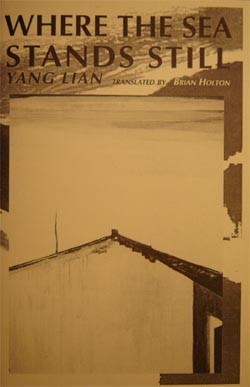From sea to screen
Yang Lian and John Cayley's iterations

The long poem “Dahai tingzhi zhi chu” 大海停止之处 by Yang Lian 杨炼 and its transformation into the collaborative digital and performance piece Where the Sea Stands Still illustrate an iterative response to digital technologies and globalization. The iterative structure of Yang Lian’s long poem produces an expanding sense of space and geography that, like the title, combines perpetual repetition with continuous change.
The long poem comprises four poems, each entitled “Dahai tingzhi zhi chu” (“Where the Sea Stands Still”). There is no numbering: each poem’s title is identical to all the others. Each has three sections and ends with “zhi chu” 之处 (where/the place where). These final characters combine stillness, spatial and temporal arrest with the sea’s ceaseless repetitive movements. The poem’s repeated images, title, final words, and structure produce a fluid sense of space: they leave the reader unsure of his or her place within the text because the usual markers of progression––such as progressive numbering, varied titles, or changes in subject matter––are absent. Adding another layer to these iterations, Yang gave the same title, Dahai tingzhi zhi chu / Where the Sea Stands Still, to the collection in which the poem first appeared. Thus each poem entitled Where the Sea Stands Still appears within the long poem Where the Sea Stands Still, which is in turn within the collection Where the Sea Stands Still. Each poem relates to all the others in wave-like expanding circles of meaning.
The poem’s repeating, expanding form is mirrored in an expanding sense of geographic and oceanic space. “Where the Sea Stands Still” is located in Sydney, Australia, where Yang held the position of writer-in-residence in 1993. He even gives his address:
King Street 一直走
Enmore Road 右转
Cambridge Street 14 号
The shift to roman script emphasizes the geographic and cultural movement between Sydney and Beijing. Elsewhere Yang contrasts Auckland, another harbor city and the place he first lived after June Fourth 1989, with “that ancient city buried in dust and yellow earth” where the “sea is only a myth.” The sea marks his geographical displacement from dry northern Beijing and his “floating life” (piaobo 漂泊)––a Chinese term for wandering or exile that chimes with the maritime theme.
Through its iterative form, the poem’s precise geographic and temporal location opens into modernity at large and into a global system of oceanic currents and geographic interrelations. Yang’s subsequent collaboration with John Cayley (and also Brian Holton, who provided the English translation, and Gao Xingjian 高行健, who supplied some of the images for the project) further expands the geographical reach of the poem, as a multimedia collaboration now encompassing China, Australia, Canada, the UK, and France. Here is a clip from the work, as performed by Yang and Cayley at the ICA in London in 1997:
This geographical constellation went truly global when Cayley subsequently published a hypertext version on the World Wide Web.
Iterations